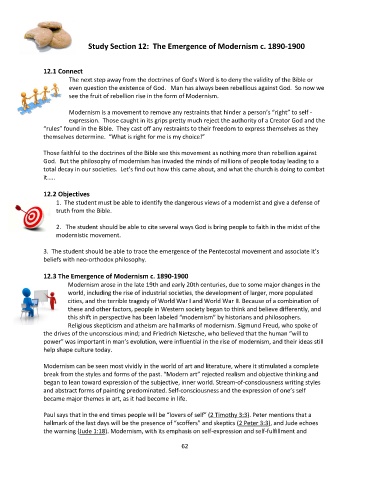Page 63 - History of Christianity II- Textbook
P. 63
Study Section 12: The Emergence of Modernism c. 1890-1900
12.1 Connect
The next step away from the doctrines of God’s Word is to deny the validity of the Bible or
even question the existence of God. Man has always been rebellious against God. So now we
see the fruit of rebellion rise in the form of Modernism.
Modernism is a movement to remove any restraints that hinder a person’s “right” to self -
expression. Those caught in its grips pretty much reject the authority of a Creator God and the
“rules” found in the Bible. They cast off any restraints to their freedom to express themselves as they
themselves determine. “What is right for me is my choice!”
Those faithful to the doctrines of the Bible see this movement as nothing more than rebellion against
God. But the philosophy of modernism has invaded the minds of millions of people today leading to a
total decay in our societies. Let’s find out how this came about, and what the church is doing to combat
it…..
12.2 Objectives
1. The student must be able to identify the dangerous views of a modernist and give a defense of
truth from the Bible.
2. The student should be able to cite several ways God is bring people to faith in the midst of the
modernistic movement.
3. The student should be able to trace the emergence of the Pentecostal movement and associate it’s
beliefs with neo-orthodox philosophy.
12.3 The Emergence of Modernism c. 1890-1900
Modernism arose in the late 19th and early 20th centuries, due to some major changes in the
world, including the rise of industrial societies, the development of larger, more populated
cities, and the terrible tragedy of World War I and World War II. Because of a combination of
these and other factors, people in Western society began to think and believe differently, and
this shift in perspective has been labeled “modernism” by historians and philosophers.
Religious skepticism and atheism are hallmarks of modernism. Sigmund Freud, who spoke of
the drives of the unconscious mind; and Friedrich Nietzsche, who believed that the human “will to
power” was important in man’s evolution, were influential in the rise of modernism, and their ideas still
help shape culture today.
Modernism can be seen most vividly in the world of art and literature, where it stimulated a complete
break from the styles and forms of the past. “Modern art” rejected realism and objective thinking and
began to lean toward expression of the subjective, inner world. Stream-of-consciousness writing styles
and abstract forms of painting predominated. Self-consciousness and the expression of one’s self
became major themes in art, as it had become in life.
Paul says that in the end times people will be “lovers of self” (2 Timothy 3:3). Peter mentions that a
hallmark of the last days will be the presence of “scoffers” and skeptics (2 Peter 3:3), and Jude echoes
the warning (Jude 1:18). Modernism, with its emphasis on self-expression and self-fulfillment and
62

